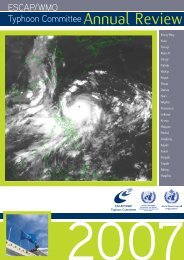TCAR - Typhoon Committee
TCAR - Typhoon Committee
TCAR - Typhoon Committee
You also want an ePaper? Increase the reach of your titles
YUMPU automatically turns print PDFs into web optimized ePapers that Google loves.
· In-house seminars. WFO Guam held two<br />
seminars for local forecasters and military<br />
components on island. The QuikSCAT seminar<br />
provided by the WFO Guam Science and<br />
Operations Office (SOO), was held on 6 and<br />
14 April. Those in attendance walked away<br />
with an understanding of the processes behind<br />
QuikSCAT and its strengths and weaknesses.<br />
The second seminar was an introduction to the<br />
Dvorak Analysis Technique by the SOO and the<br />
Guam WCM.<br />
· Tropical Cyclone Conference. Commander in<br />
Chief US Pacific Fleet (CINPACFLT) held a Tropical<br />
Cyclone Conference and the METSAT Conference<br />
from 27 April to 1 May at Pearl Harbor, Hawaii.<br />
Some highlights from the conference included<br />
a discussion on the Automated Meteorological<br />
Observing System (AMOS) network, the potential<br />
loss of Scatterometer and ocean wave altimetry<br />
data, and the civilianization of the JTWC Director<br />
and three forecasters to improve continuity<br />
and experience. JTWC also celebrated it 50 th<br />
Anniversary, inviting past JTWC Directors and<br />
Navy Commanders to attend the ceremony.<br />
· Mr. Richard Grumm, Science and Operations<br />
Officer, NWS State College, Pennsylvania,<br />
presented a detailed three-day seminar, 9 to<br />
11 September to WFO Guam personnel on the<br />
use of NWP ensemble techniques for improving<br />
forecasts in the tropics. His presentations<br />
were well received and greatly enhanced all<br />
participants’ appreciation for the latest NWP<br />
techniques, especially in better understanding the<br />
degree of uncertainty and probabilities associated<br />
with tropical cyclone track predictions.<br />
· WFO Guam SOO participated in a community<br />
white paper presented at the OceanObs’09<br />
symposium, Venice, Italy 21-25 September on<br />
the satellite-derived surface winds component<br />
of the observing system, with applications for<br />
operations and for climate prediction.<br />
· From 1 January to 31 October, the Pacific<br />
International Desk Training Programme,<br />
RSMC Honolulu, Hawaii Islands, USA trained 6<br />
forecasters from 6 different members of WMO<br />
Regional Association (RA) V regions, including<br />
Samoa, Vanuatu, New Guinea, Philippines,<br />
Solomon Islands, and Tonga. Since its inception<br />
in 2001, 52 people from 15 Members of WMO RA<br />
V and 2 Members from the <strong>Typhoon</strong> <strong>Committee</strong><br />
<strong>TCAR</strong><br />
CHAPTER 1 - TYPHOON COMMITTEE ACTIVITIES<br />
have attended this programme. The USA<br />
government, through NOAA NWS funded the<br />
training programme.<br />
· FEMA and the Hawaii State CD Catastrophic<br />
Disaster Event Planning. FEMA, Hawaii State CD,<br />
the University of Hawaii, Pacific Disaster Center,<br />
and RSMC Honolulu completed the development,<br />
exercise, and validation of the Hawaii Catastrophic<br />
Hurricane Readiness Response Plan in 2009.<br />
The plan features a strong Category 4 hurricane<br />
hitting the most populated area of Honolulu,<br />
Hawaii. As part of this planning, the University<br />
of Hawaii developed a very sophisticated Storm<br />
Inundation model for island communities with<br />
coral reefs. RSMC Honolulu developed 12<br />
hurricane tracks with varying tracks, speed of<br />
movement, intensity, and size. FEMA executes<br />
part 1b of the plan with a hurricane in the central<br />
Pacific approaching Hawaii, and 1c either when a<br />
watch is issued for the islands or the probability<br />
of hurricane force winds are between 10 and 20<br />
percent for any place on the islands. At stage 1b,<br />
FEMA expends significant funds by pre-locating<br />
people and resources, because of the isolated<br />
nature of the Hawaiian Islands.<br />
· As part of the Hollings Scholar program, a<br />
student from Florida State University spent 9<br />
weeks at RSMC Honolulu. This scholar along with<br />
the Deputy Director of RSMC Honolulu conducted<br />
studies of probabilistic tropical cyclone genesis in<br />
the central Pacific. All available data on tropical<br />
cyclones were used with Dvorak fixes as one of<br />
the major data sources. This research continues<br />
and in the future may involve RSMC Miami and<br />
the Atlantic Ocean.<br />
· RSMC Honolulu continues to advocate for<br />
real time ocean vector winds for the future. The<br />
Deputy Director is part of the Operations Team<br />
associated with the planning, development, and<br />
coordination with NASA, Japan, and others on<br />
replacements to Quikscat winds.<br />
· Wind probabilities for tropical storm and<br />
hurricane force winds out to 120 hours play an<br />
important part in the ability of RSMC Honolulu<br />
to communicate risks to emergency managers<br />
and other decision makers. RSMC Honolulu is<br />
working with RSMC Miami on a Joint Hurricane<br />
Testbed project to continue to improve the<br />
beneficial use of these probabilistic winds.<br />
· Hurricane Specialists and Hurricane<br />
2009<br />
141

















